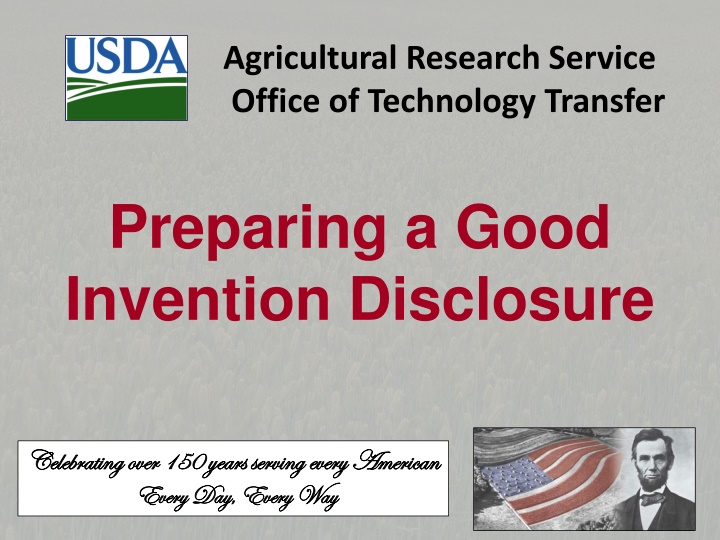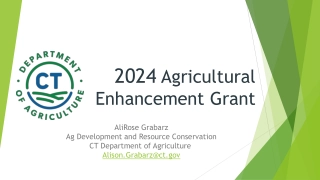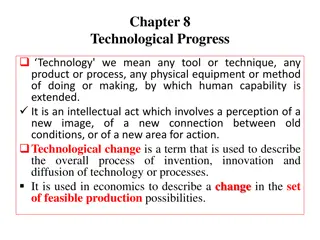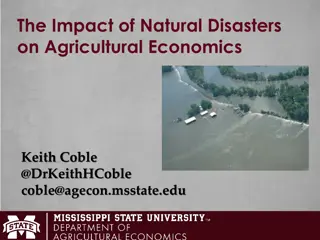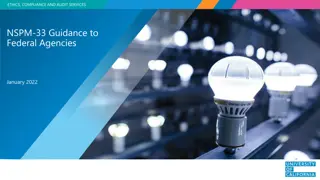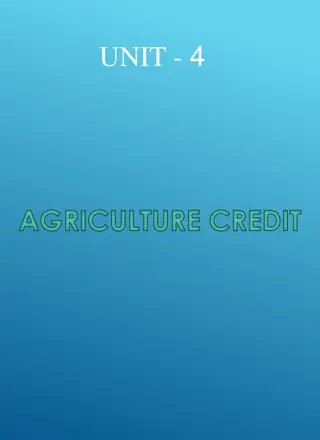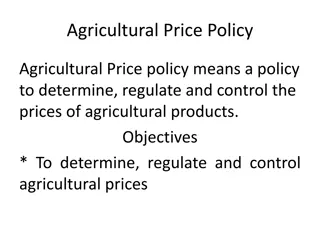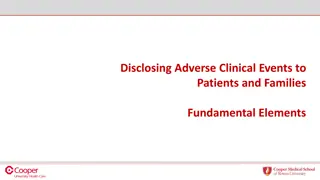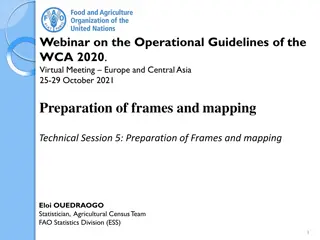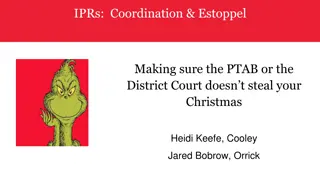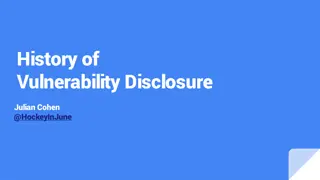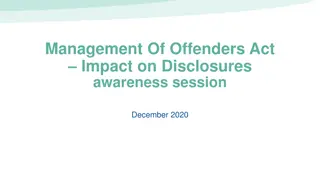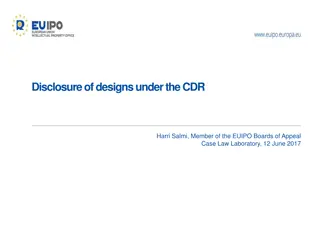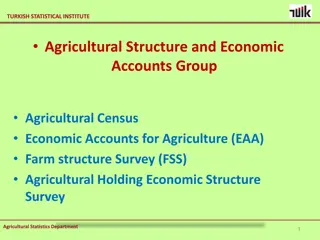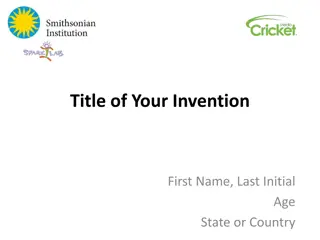Agricultural Research Service: Invention Disclosure Guidelines
An Invention Disclosure is a confidential document prepared by inventors to describe new inventions in detail, including problem-solving aspects, commercial potential, technological significance, and more. It helps in determining patentability and guiding the patent application process.
Download Presentation

Please find below an Image/Link to download the presentation.
The content on the website is provided AS IS for your information and personal use only. It may not be sold, licensed, or shared on other websites without obtaining consent from the author.If you encounter any issues during the download, it is possible that the publisher has removed the file from their server.
You are allowed to download the files provided on this website for personal or commercial use, subject to the condition that they are used lawfully. All files are the property of their respective owners.
The content on the website is provided AS IS for your information and personal use only. It may not be sold, licensed, or shared on other websites without obtaining consent from the author.
E N D
Presentation Transcript
Agricultural Research Service Office of Technology Transfer Preparing a Good Invention Disclosure Celebrating over 150 years serving every American Celebrating over 150 years serving every American Every Day, Every Way Every Day, Every Way
What is an Invention Disclosure A confidential document written by an inventor describing a new invention in detail, including how it is different from the state of the art. ARS invention disclosures are entered through ARIS National Patent Committee reviews the invention disclosure and accompanying documents to recommend whether patent protection should be sought or if the invention is better transferred to the public through another means (e.g., by publication) OTT s Patent Advisors also use the invention disclosure to evaluate patentability and to assist in the patent application and prosecution process
Contents of an Invention Disclosure Title of the Invention Q1: Describe the invention in detail What problem is solved? How does it work? Potential changes and variations to the invention Other information can be attached, including diagrams, structures, pictures; sequence listings and deposit information; and data and protocols Q2: Commercial potential, including what advantages the invention has over what already exists Q3: Public disclosures Q4: People who contributed to the invention Q5: Technology significance Q6: Technology stage Q7: What additional research may be needed Q8: List of outside funding/agreements Inventor(s) information
Q1: Describing the Problem(s) Solved Provide detail on the problem and background An in-depth treatise is not necessary, but a primer on the existing problems your invention addresses will help orient your audiences to the benefits of your invention New solutions to a problem Describe the aspect(s) of the problem your invention solves If there are other solutions available, what is the benefit of your invention over them? Updates/modifications to existing technology Describe the existing technology and how your invention improves it What aspects does your invention improve upon (e.g. efficiency, usability, and/or consumer desire)?
Q1: Problem(s) Solved (Contd) The disclosure should effectively answer each of these questions: Why is your invention necessary? What is the conventional solution to the problem? Why is your solution better than the conventional solution? Would your solution be obvious to a technologically experienced user in view of the conventional solution? Why not?
Q1: Describe the Invention: How does it work? This is not always obvious to the various audiences that will read your disclosure Include a detailed written explanation that can guide someone through how the invention works and how it can be practiced/used When applicable, flowcharts, diagrams, chemical structures and/or mechanical drawings should be submitted to easily visualize the workings of the invention
Q1: Describe the Invention: Diagrams The most direct way to describe many inventions is to use a visual representation, which can be attached to the invention disclosure itself. The best type of visual representation is dependent on the subject matter of the invention: For mechanical inventions, an annotated drawing, photograph, schematic, or flow chart is usually best For chemical inventions, a diagram of a chemical structure and/or sequence of reactions may be helpful For a biotech invention, sequence listings may be appropriate For some inventions, a combination of techniques may be appropriate
Visual Representation: Annotated Line Drawing This is practically required for a mechanical invention Describe the function of the apparatus by referring to the reference numbers in the figure(s). Although a clean line drawing is preferred, a simple hand drawing may suffice for the purposes of the invention disclosure
Visual Representation: Labeled Photographs Although labels are used here, reference numbers may also be used and the labels may be hand drawn. They say a picture is worth a thousand words and that is true here too.
Visual Representation: Flow Chart A simple method or process invention can be visualized in this manner: Start image acquisition from the sample Move positioning table one step Acquire one line of line scan image data from the sample Show acquired image and spectral data in system software No Is this the last scan for the sample? Yes Show acquired image and spectral data in system software The Patent Office generally requires method inventions to be described as a series of steps. One way to help a reader visualize your method is through a flow chart.
Visual Representation: Flow Chart A more complex method may look like this: Dehull Barley Barley Hulls Dehulled Barley Kernels Treat Hulls with Alpha Amylase and Glucoamylase to Produce Glucose Glucose Process into Ethanol Destarched Barley Hulls Hydrolyze to Produce Xylose Residual Solids Hydrolyzed to Produce Glucose Glucose Pretreat Hulls by Soaking in Aqueous Ammonia (SAA) OR Soaking in Ethanol and Aqueous Ammonia (SEAA) to Facilitate Enzyme Hydrolysis Process into Value- added products (e.g. astaxanthin) Xylose
Visual Representation: Chemical Reactions In chemical cases, pictorially representing a reaction may be crucial to helping the reader understand the invention.
Visual Representation: Chemical Structures Chemical compounds structures and potential analogs can be given in two ways: R1 3 2 4 1 5 6 9 R2 7 8 wherein R1 is hydrogen, an oxygen, a C1-10 alcohol (straight or branched), aldehyde, alkyl, ether (e.g. methanol, ethanol, ethanal, 4-methylhexane, heptyloxymethane), or esters of said alcohol with a C1-10 saturated or unsaturated, straight or branched acid (e.g., formic acid, acetic acid, 2-methylbutyric acid, 3-methyl-2-butenoic acid) and R2 is hydrogen, an oxygen, a C1-10 alcohol (straight or branched), aldehyde, alkyl, ether (e.g. methanol, ethanol, ethanal, 4-methylhexane, heptyloxymethane), or esters of said alcohol with a C1-10 saturated or unsaturated, straight or branched acid (e.g., formic acid, acetic acid, 2-methylbutyric acid, 3-methyl-2- butenoic acid); optionally there is a double bond between carbons 5 and 6 and R2 is hydrogen. Preferably R1 or R2 are hydrogen (in other words, R1 can be hydrogen or R2 can be hydrogen or both R1 and R2 can be hydrogen). Preferably R1 and R2 are not both hydrogen (in other words if R1 is hydrogen then R2 is not hydrogen or if R2 is hydrogen then R1 is not hydrogen).
Q1: Describe the Invention: Variations When describing your invention, you should describe a preferred embodiment (i.e. configuration) of your invention as well as any and all alternative embodiments which are variations of the preferred embodiment In a mechanical invention, this may mean using similar but different materials or arranging components in a different configuration to get the same or an alternative desired result In a method invention, it may mean adding or deleting process steps In a chemical invention, it may mean modifying reactants, reaction variables, or catalysts, but still achieving a desired result In a biotech invention, it may mean using alternative sequences
Q1: Describe the Invention: Sequence Listings Patent applications containing nucleotide sequences and/or amino acid sequences require a standard format for submitting the sequence data in a separate document, the Sequence Listing. Sequences should thus be provided to OTT in a word or text file so that they can be imported properly. We can claim the nucleic acid sequences of e.g., constructs, rationally designed viruses; nucleic acid sequences that encode fusion proteins; cDNA molecules and the polypeptides they encode. If a cDNA nucleic acid sequence is claimed, the amino acid sequence it encodes should also be included When you provide us with the sequences, they should be the final correct sequences. We cannot change or add to the sequences once we file the application.
Interlude: Biological Deposit Biological materials include materials that are capable of self-replication, such as cells, cell lines, hybridomas, bacteria, fungi, yeast, algae, protozoa, plasmids, viruses, plant tissue cells, lichens and seeds For an invention involving a biological material to be considered enabled, the biological material must be deposited at Depository recognized by Budapest Treaty, e.g., ATCC American Type Culture Collection NRRL ARS Culture Collection (National Regional Research Laboratory) A strain that results from a selection process can be considered not a product of nature, i.e., not a problem for patentability under 35 U.S.C. 101, and therefore a candidate for deposit Deposits must be made before the application is filed
Q1: Describe the Invention: Experiment Protocols and Data Yes, we need it all! Provide the protocols and data of the experiments that generated and confirmed the invention; if necessary this can be provided in a word/text/powerpoint/etc. file attached to the invention disclosure itself If data is not self-explanatory to someone who doesn t work in your field of study, explain the data and how the data confirm that the invention works as described National Patent Committee members want to see your data!
Q1: Protocols and Data (Contd) If a patent application is filed, the protocols and data will be included in the patent application, and thus they should be submitted with the invention disclosure If all of the data and protocols are included in a draft manuscript which you are providing with the invention disclosure, then that is sufficient If you do not have a draft manuscript yet, when will you have one?
Q1: Protocols and Data (Contd) OTT requires data demonstrating that the invention works as described If there are no data or insufficient data, the invention disclosure will likely be suspended
Q1/2: Problem-Solution Statement Make sure the following information is addressed in either of questions 1 or 2: Describe the technical area(s) and commercial sector(s) where your invention would have use and benefit Briefly describe the problem that currently exists and how your invention solves the problem Describe any modifications or alternatives to the invention that will still solve the problem Describe the reasons there is an industrial or commercial need to solve the problem your invention seeks to solve Provide examples of how others have attempted to solve the problem and explain the shortcomings of those solutions
Q2: Advantages of the Invention Describe the main advantage of your invention. Due to the different audiences reading your Disclosure, it is helpful to have this expressed in both in a one sentence, bottom-line form, and in a more complete detailed form as well. Describe how the invention is superior over currently used or known solutions to the same problem Discuss advantages related to cost savings, environmental benefits, efficient use of resources, etc.
Q2: Potential Market Discuss the commercial potential of the invention in terms of the total market for the technology Discuss the estimated percentage of the total market likely to accept and use your invention Discuss estimated cost or resource savings potential for the industry Discuss competitive advantage of your invention Discuss names and sizes of specific companies (if known) that may be candidates for commercial partners or potential users of the invention
Q3: Public Disclosures A public disclosure of the invention, or of something closely related to the invention, can materially impact timing and rights. Knowing what has been disclosed when is imperative for the Patent Committees and OTT staff to making informed decisions on patentability. If you have any questions as to whether a disclosure may have impacted patent rights, contact a patent advisor.
Q4: People Who Contributed List all people who are potential inventors Inventorship v. authorship Inventorship: contributed to the conception and reduction to practice of the invention Authorship: conducted research or testing under your supervision Patent Advisor will review & discuss this information with you For each non-ARS inventor, provide contact information for Scientist/technician Employer Technology transfer office or legal department
Q7: Describe the Invention: Upcoming Developments Are you conducting ongoing experiments and/or planning future experiments involving the invention? Explain the purpose of the experiments (reason for conducting them) and the anticipated completion date for the experiments Regardless of what is currently planned, what future development would be necessary to commercialize the invention? (scale-up, clinical trials, incorporation with other technology, etc.)
Other Information to Supply Identify proprietary material used in experiments Provide agreement covering that material If no agreement exists, explain how the material was obtained If the research was performed under a CRADA, provide CRADA number and/or copy of the CRADA and any amendments Provide abstracts, slides, articles, & manuscripts which discuss the invention; these can be attached to the invention disclosure Provide citation, if available, and/or date that information was publicly available
Thank you! If you have any questions, contact a Patent Advisor: Life Science David Marks Mark McNemar Ari Atkinson Chemical Byron Stover Ari Atkinson Ediz Yonter Engineering Robert Jones Supervisor Gail Poulos
